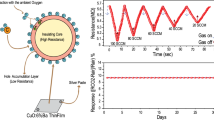Abstract
Monitoring of trace water in industrial gases is strongly recommended because contaminants cause serious problems during use, especially in the semiconductor industry. An ultra-sensitive trace-water sensor was developed with an in situ-synthesized metal-organic framework as the sensing material. The sample gas is passed through the sensing membrane and efficiently and rapidly collected by the sensing material in the newly designed gas collection/detection cell. The sensing membrane, glass paper impregnated with copper 1,3,5-benzenetricarboxylate (Cu-BTC), is also newly developed. The amount and density of the sensing material in the sensing membrane must be well balanced to achieve rapid and sensitive responses. In the present study, Cu-BTC was synthesized in situ in glass paper. The developed system gave high sensing performances with a limit of detection (signal/noise ratio = 3) of 9 parts per billion by volume (ppbv) H2O and a 90% response time of 86 s for 200 ppbv H2O. The reproducibility of the responses within and between lots had relative standard deviations for 500 ppbv H2O of 0.8% (n = 10) and 1.5% (n = 3), respectively. The long-term (2 weeks) stability was 7.3% for 400 ppbv H2O and one-year continuous monitoring test showed the sensitivity change of <~3% before and after the study. Furthermore, the system response was in good agreement with the response achieved in cavity ring-down spectroscopy. These performances are sufficient for monitoring trace water in industrial gases. The integrated system with light and gas transparent structure for gas collection/absorbance detection can also be used for other target gases, using specific metal-organic frameworks.
Similar content being viewed by others
References
J. Feng, R. Clement, and M. Raynor, J. Crystal Growth, 2008, 310, 4780.
J. Yao, H. Funke, and M. Raynor, Taiyo-Nissan Gihou, 2004, 23, 43.
K. Hashiguchi, D. Lisak, A. Cygan, R. Ciuryło, and H. Abe, Sens. Actuators, A, 2016, 241, 152.
J. T. Hodges and D. Lisak, Appl. Phys. B, 2006, 85, 375.
J. Tao, Y. Luo, L. Wang, H. Cai, T. Sun, J. Song, H. Liu, and Y. Gu, Sci. Report, 2016, 6, 29672.
D. Saha, S. Das, and K. Sengupta, Sens. Actuators, B, 2008, 128, 383.
S. Ohira, K. Goto, K. Toda, and P. K. Dasgupta, Anal. Chem., 2012, 84, 8891.
C. D. Mowry, A. S. Pimentel, E. S. Sparks, M. W. Moorman, K. E. Achyuthan, and R. P. Manginell, Anal. Sci., 2016, 32, 177.
H. Abe, Synthesiology, 2009, 2, 206.
S. Ohira, Y. Miki, T. Matsuzaki, N. Nakamura, Y. Sato, Y. Hirose, and K. Toda, Anal. Chim. Acta, 2015, 886, 188.
C. Zhao, Y. Liu, and Y. Li, Anal. Sci., 2015, 31, 1035.
D. Farrusseng, “Metal-organic Frameworks Applications from Catalysis to Gas Storage”, 2011, Wiley-VCH Verlag, Weinheim, Germany.
P. Davydovskaya, R. Pohle, A. Tawil, and M. Fleischer, Sens. Actuators, B, 2013, 187, 142.
L. E. Kreno, J. T. Hupp, and R. P. Van Duyne, Anal. Chem., 2010, 82, 8042.
E. Biemmi, A. Darga, N. Stock, and T. Bein, Micropor Mesopor. Matter., 2008, 114, 380.
L. Grajciar, O. Bludsky, and P. Nachtigall, J. Phys. Chem. Lett., 2010, 1, 3354.
S. Ohira, P. K. Dasgupta, and K. A. Shug, Anal. Chem., 2009, 81, 4183.
S. Ohira, E. Wanigasekara, D. M. Rudkevich, and P. K. Dasgupta, Talanta, 2009, 88, 1814.
T. Orii, T. Okazaki, N. Hata, K. Sugawara, F. A. Rahman, and H. Kuramitz, Anal. Sci., 2017, 33, 883.
D. Nagaraju, D. G. Bhagat, R. Banerjee, and U. K. Kharul, J. Mater. Chem. A, 2013, 1, 8828.
C. M. Hansen, Prog. Org. Coat., 2001, 42, 167.
G. W. Peterson, D. K. Britt, D. T. Sun, J. J. Mahle, M. Browe, T. Demasky, S. Smith, A. Jenkins, and J. A. Rossin, Ind. Eng. Chem. Res., 2015, 54, 3626.
M. Amano and H. Abe, Meas. Sci. Technol., 2016, 28, 025007.
C. Ji, L. Ma, M. Yin, W. Yang, and K. Pan, Chem. Asian J., 2016, 11, 2316.
H. Lee, S. H. Jung, W. S. Han, J. H. Moon, S. Kang, J. Y. Lee, J. H. Jung, and S. Shinkai, Chem. Eur. J., 2011, 17, 2823.
G. Nickerl, I. Senkovska, and S. Kaskel, Chem. Commun., 2015, 51, 2280.
Acknowledgments
Part of this project was supported by the Japan Science and Technology Agency (JST), Adaptable and Seamless Technology Transfer Program through Target-driven R&D (A-STEP), No. AS2621318M, and JSPS KAKENHI Grant-in-Aid for Young Scientists (B) Grant number JP26810076.
Author information
Authors and Affiliations
Corresponding author
Electronic supplementary material
Rights and permissions
About this article
Cite this article
Ohira, SI., Nakamura, N., Endo, M. et al. Ultra-sensitive Trace-Water Optical Sensor with In situ-synthesized Metal-Organic Framework in Glass Paper. ANAL. SCI. 34, 495–500 (2018). https://doi.org/10.2116/analsci.17P453
Received:
Accepted:
Published:
Issue Date:
DOI: https://doi.org/10.2116/analsci.17P453




